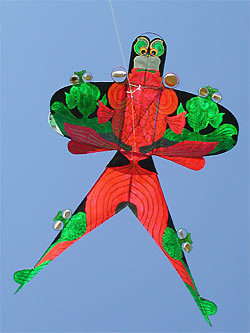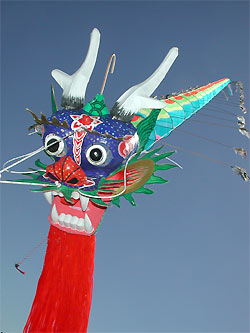Kite Tradition in the World |
"Looking at the historical annals, we see that the kite has a long history, but as to know who was the inventor we can not actually find anything definite ..." Thus spake Cao Xuequin ( "Hawks South, Milan North" -1757 - China). |
| CHINA | NEPAL | INDIA | AFGHANISTAN | KOREA | JAPAN | INDONESIA | MALAYSIA | |||
| THAILAND | CAMBODIA | VIETNAM | BRAZIL | BOLIVIA | CHILE | COLOMBIA | GUATEMALA | CURACAO | ||
Throughout our journey we follow the thread of our kites. We were surprised by the variety of kites around the world, by design (materials, shapes ..) and their symbolism. Our friends kite flyers of "Bout du Monde", met at festivals, particularly at Dieppe, showed us through their stories, legends and traditions of kite flying in their country. We want to share their stories with you waiting our experience during our trip. |
Li Ruo Xin (Bei jing) told us a few symbols. Today we still do not know how we understood, we do not talk at all the same language! The crab divert bad luck, the bat is the perfect happiness and fish is the harmony of the couple. When the swallow is "thin" it represents the feminine, whether she is "fat" is the longevity offered to boys. The dragon, which legend says he would be able to bring rain, is a symbol of power. He is often carrying a red beard (supernatural powers). Art People increasingly practiced, the kite has, for the Chinese, beneficial effects on health, and remains an expression of freedom. |
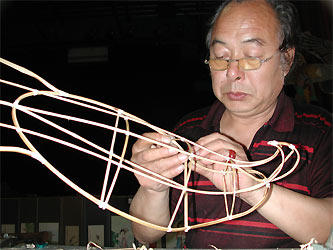 |
In 2004, Patrick has learned under the uncompromising eyes of our Chinese friend Wang Zhushan (Yantai) to make an eagle bamboo. (Left photo) After 4 days, he has become a Chinese worker under the command of "Master": work, work and not eat much ... To make these superb flying animals, there are three steps: making the bamboo frame (skeleton), paste the silk or paper on the frame and paint it. Once the veneer of bark removed, the bamboo is cut and bent by the heat (alcohol lamp, for example). While cooling, it retains the form given. The bamboo is then split into two in order to achieve perfect symmetry (eg the right wing / left are made in one piece) necessary |
for a stable flight. Then the pieces are tied and glued. This gives the frame of the kite, its skeleton. For kites silk, it is wetted and then stretched and glued on the frame. As it dries, it shrinks and fits perfectly on the skeleton. |
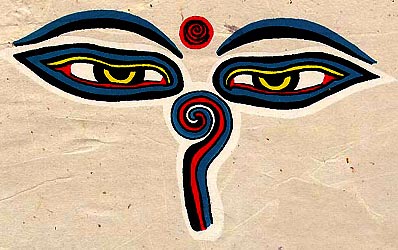 |
|
We met Nirma Man Tuladhar who told us that in Nepal the kite is associated with a great feast: Daisain. It is the festival of harvest, which is celebrated during the rice harvest, in honor of the Goddess Durga. All castes and creeds, Hindus and Buddhists celebrate this festival. According to a belief "with the kite we send messages to the gods: the rice harvest is over, so they can stop the rain". In this season, the weather is nice and clear skies. This is the best time to kite. The season lasts a month and ends for "Tihar" festival of light. The kites are appointed Malay Nepali, "diamond-shaped". They are richly decorated with motifs of architecture and culture of Nepal. They are made of bamboo and paper. The handmade paper, the "Lama Li" is one of the most beautiful in the world. It is made from a plant known as "Lokta". |
| This paper is robust and allows to build kites resistant to high winds and moisture.But mostly he has a transparency that allows you to see the beauty of its structure composed of long fibers intermixed. (Right: detail of a pattern on a paper kite Nepalese by Nirma Man Tuladhar) The thread holding the kite is very abrasive made with powdered glass. During Dasain, the roofs of large cities are covered with kites and during the fighting, the pilot shouted "Cét" when they cut the kite of others. |
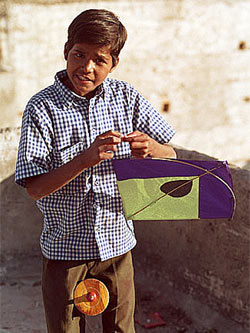 |
||
Continue our trip in Asia, especially India with Abdul Rauf (Mumbai). The Kites in India date back to the invasions Monghols (Muslims). Therefore, even today, are the Muslims who make them. The kite has always had a special place in the history of India, it is a culture that affects all strata of society. This is one of the few gatherings of all Indian communities. |
||
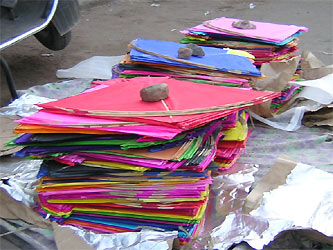 |
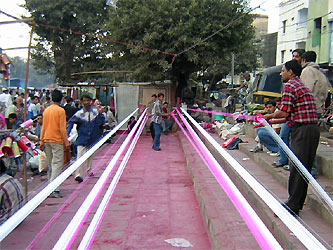 |
|
You can find kites throughout India, but some regions are more involved: the Uttar Pradesh for Patang Wallah (manufacturers of kites) and Manjha Wallah (manufacturers of wire cutting). Our friend Abdul is recognized as "Ustad Patang Wallah", that is to say, he excels in the manufacture of its kites. |
| The Patang are made from bamboo and Indian paper.They are fast and maneuverable. The cuting line, the "Manjha" is made of crushed glass, rubber, pulp of cooked rice and coloring. This mixture is then coated on cotton thread stretched between two poles. (Pictured right) Some areas are famous for their meeting, as Rajhastan with the festival of Jodhpur and Gujarat and festival of Ahmedabad. In the days preceding the festival in Ahmedabad, fabrication shops are in turmoil. In a sixteen-hour day, four workers can produce up to 5 000 Patang. The day of "great battle", entire families are massed on the roofs of houses with piles of kites and Manjha of all colors. They are ready to take until sunset. The Patang fight is to cut the line of the other and remain the last flight: Festival in Ahmedabad in 2004 Flying a kite fighting is pretty simple. Patrick and I take great pleasure in making change. Participate in a fight is something else ... Even with the guidance of Dilip (Mumbai) and Ludovic Petit course ... it's not earned! |
|
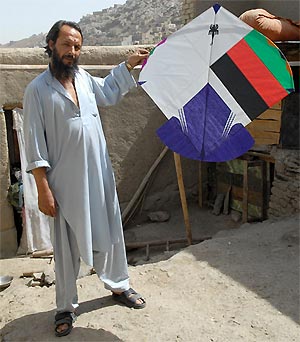 |
|
In Afghanistan the kite is called "Goudi Paran" (literally flying doll). In Afghanistan, we played kite on Friday (day off) and only in winter (period of school holidays). Each neighborhood, each street had its champion. On Friday morning, Goudi Paran Baz (pilot) climbed onto the roofs of houses and a variety of kites then took flight. When Goudi Paran was released from its string, shouts of joy greeted the winner, but the Goudi Paran Baz knew that victory is always ephemeral. A team consists of two people: the Goudi Paran Baz, who is the pilot of the kite, and Charka Gir is responsible for the coil. Children are not the only ones excited about the kite, many men practice fighting with wire cutting called "Tar-e-shis. It is coated with a mixture of glass powder and paste and glutinous rice wrapped around a spool: the Tarcharka. There were no official competition, but the Goudi Paran Baz organized themselves tournaments and bet. Small kites for children were called "Patingak" (butterfly) or "Mahibak" (small fish). But after ten years of confrontation against the Soviet Union, followed by a deep civil war and ethnic patterns have been disrupted. Worse, the Taliban came to power have completely banned the practice of kite, (the 7th of the 16 commandments Taliban) as well as many other children's games, whereas it was detrimental to the study of the Koran. Under Taliban rule, if you were caught with a kite, you were beaten and the coil was destroyed. However, since the fall of the Taliban regime, the Gudiparan Bazi brand new surface. See our story on the "Kite of Kabul" (Kite Runner) |
|
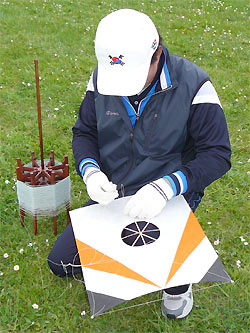 |
|
Across China, Korea, are also fighting kites. At all times, kites Korean (yeon) were used by warlords to transmit coded messages. There are over 400 years, during the invasion of Korea by Japan, an admiral used kites to communicate with his soldiers. Their designs and colors perfectly codified, informing the troops on the evolution of fighting and passed and operation orders. It was particularly used during the conflict aboard the warship the Korean Seon-Keobuk or "Turtle Boat". But this method of communication but its terms of use in bad weather (fog, rain, snow, etc..). Today the Korean kites are carriers of messages: the birth of a child can write his name on the kite and let it escape into the sky. Thus all the evil spirits away by the wind. The Korean kites are easily recognized: they are rectangular, with a bamboo frame, glued onto paper, and a hole in the middle. They fly without tail and their stability are given dihedral bending of the yard. They were flying very high. For fighting, the lines, covered with a mixture of resin and glass powder or synthetic diamond powder, are made very abrasive. A few years ago, we took advantage of the presence of Korean kite flyers to Ludovic Petit (Manjha Club) to make a Bangpae yeon. |
|
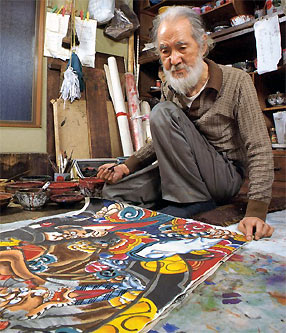 |
||
In their Japanese neighbors, the lines are traditionally made of linen, it does not use abrasive cord for fight. The Rokkaku, kite fighting is traditionally decorated with heads of warriors very expressive. |
||
Again, the rules of engagement are simple: the last flight was declared the winner. The Rokkaku fight has become a must for festivals. We participated in many fight and Patrick won a few. These games are more than 200 years. The origin of these fights date back to struggles for power that engaged the owners of rice fields. The Rokkakus were launched from each bank and flew over the water. Trampling teams on the riverbanks, during takeoff, had the beneficial effect of consolidating the banks often flooded during heavy rains. Initially, only the wealthy samurai could build kites, paper and bamboo. Indeed the paper was expensive. Later the kite becomes more popular thanks to new techniques for making paper less expensive. |
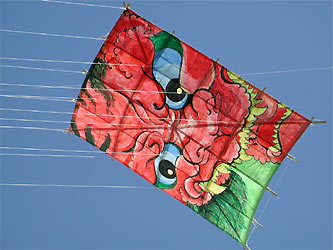 |
|
This is the Edo period. It is also the height of the kite. Among other kite known, the Edo (pictured above) which takes its name from the former name of Tokyo. Very long straps stabilize its flight. They are hand painted and depicts scenes with warriors, popular actors theater or calligraphy. |
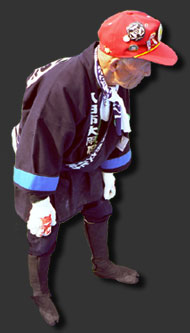 |
Each region has adopted specific forms of construction and decoration of his kites. The Hamamatsu flies at the festival of boys, in May, to wish them health and success. |
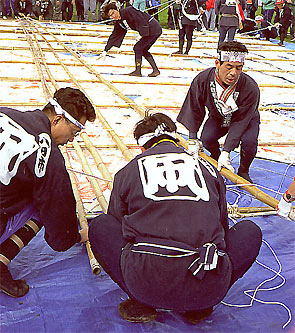 |
Then he took his drum and hammered slowly to announce the flight. The kite is curved. A long whistle sounded. That's the signal! Wooden poles straighten the kite into the wind and the giant 200 kg take off. |
Continuing our tour of Asia, we take you to Indonesia. |
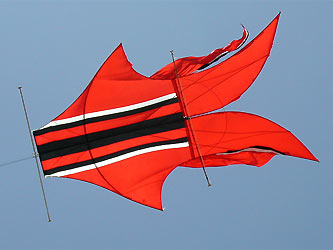 |
Other kite, the kaghati is entirely made with cassava leaves found on the island of Sulawesi. The lines were made of pineapple fiber woven. In this Indonesian island, farmers use these kites to their crops. Installed in the fields at planting time, the kaghatis are equipped with a arc sound to scare birds. At Lombok and parts of South Sulawesi, some fishermen use sheets Kolak (sort of fern that grows on the roofs of houses) for the fishing kite. This fishing technique has the advantage of not arousing the suspicions of fish, the fisherman on his boat was well away from the bait. |
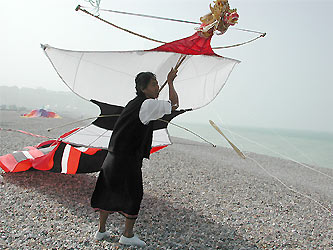 |
Kites of Bali are our most impressive by the beauty of their achievement, the grace of their flight in the air. |
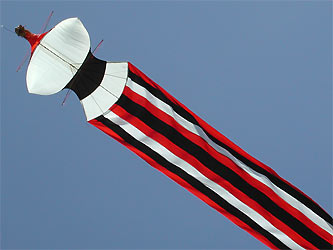 |
The Be-Bean (pictured above middle) fly by imitating the swimming fish. It has two arches of sound. The time of flight is beautiful kites occupy the sky, the enthusiastic audience encourages teams and children play with small kites they have made. After the festival, kites are exposed in their city or village. Construction has already begun for the next edition. In Sumatra kites are close to their cousins in Malaysia and Thailand |
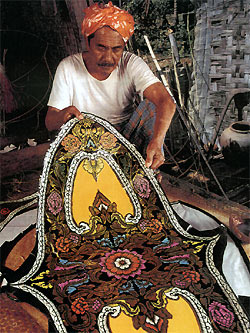 |
||
In Malaysia, the kite has the status of national icon. We can found it on coins, stamps and even on the fuselage of airplanes national airline, whose decoration is different than a kite stylized. Les Wau , du nom hollandais Wouw (grand oiseau de proie de l'Asie du sud-est), sont fabriqués en papier et bambou . The Wau Holland named Wouw (large bird of prey of Asia South East) are made of paper and bamboo. |
||
The paper is divided into lace. The sheets are bonded and worked on each other with glue rice. The result is a stained glass effect. They are mostly equipped with a sound arc, consisting of a thin strip of palm stretched over a flexible bamboo. Malaysia has been flooded for much of its history. Thus in his kites all the cultural influences that have stayed on its soil: the Chinese have brought the quality of bamboo work, the Indian transparency and balance of the wing, while the decorations are of Islamic. The Malay kite is a wonderful synthesis of all arts and skills Oriental. The Wau Bulan (moon kite) is the most popular. It is manufactured in the north-east. Its natural dihedral gives it a very good aerodynamics. |
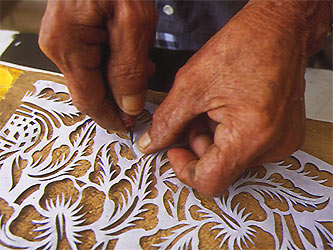 |
|
| Like Wau Kuching (cat kite) or Jalabudi Wau (Kite wife), its motives are flowers and leaves. The upper part of the kite is called "Sayap. It has two eyes "lelok" and head "kepola" adorned with fringes "Belak. The lower "punp pong" has pompoms called "Jambul". |
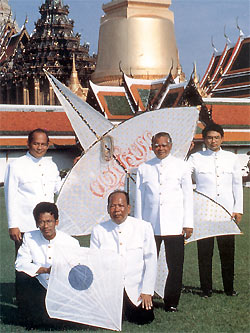 |
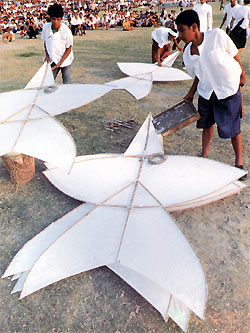 |
|
In Thailand, in fighting competitions, sex Kite is important, since there are kites male "Chula" and kites females " Pakpao". The Chula (pictured right) is a large kite with a minimum length of 2m25. Its silhouette is that of a star with 5 branches and it has 3 sets of bamboo hooks attached to his rope to catch the female. The Pakpao, as the image of the female it is, appears fragile, cut into diamond shape and measuring 75 cm maximum. Its defense is its ease of operation and a loop of rope fastened under his line of flight. It wears a long tail that can grab his opponent and roll. By 1906, the reign of Chulalongkorm, the first "Royal Cup" took place at the Dusit Palace. The king presided over the competition, which became a national sport. The successive kings were wont to hire their Chula against the Pakpao handled by their courtiers on the Phramane esplanade, opposite the Palais Royal, where fighting is still taking place today. The members of Thai kites Heritage Group (left) explains the rules of this fight: |
The land is divided among a rope. The Chula territory is located inwind. Hence the big kite is launched in the territory of Pakpao. The fight is for the Chula catch one or several females with bamboo hooks and back into its territory. It takes 10 men to handle a Chula. Pakpao must capture the male with its loop of rope or tail for balance and throw it to the ground. Handled by experts, the charming little Pakpao is a formidable opponent for Chula. |
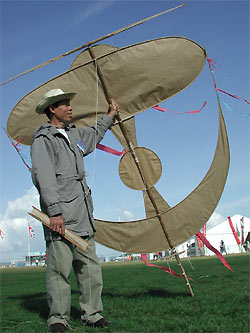 |
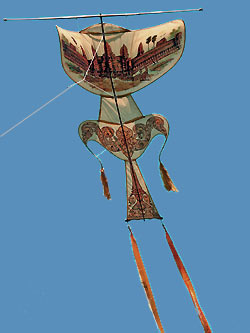 |
|
Since several years we find pleasure with the Cambodian delegation at the Festival of Dieppe (left) with Sim Sarak, director of administrative services of the Ministry of Culture, and his wife. Sim Sarak is also the cause of return, in 1994, of the festival of kites in Cambodia. |
The arc of sound, called "ek" is rattan. It is fixed on the top of the kite. A good sound arc emits several tones and each kite makes a different sound. The farmers are flying mostly at night to hear the song of the arcs of sound. Depending on their flight, the monks augur of drought or rain for the coming year. More about the legends of Kleng |
|
|||
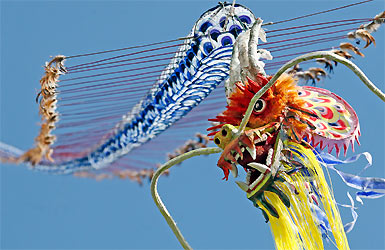 |
Mr. Nguyen Van Be said that when they climb into the sky by high winds, these kites Vietnamese sing. The air rushes into the resonator and produces a wailing sound which is heard from a distance. The resonators are often superimposed, the number three or four (right) and even eight. Then they give a more low sound. They are the subject of religious beliefs and superstitions can exorcise evil spirits. The kites are heavily inspired by contemporary models of Chinese butterflies, birds, fish, dragon (left), bat ... with more vivid colors but less finesse in the details. |
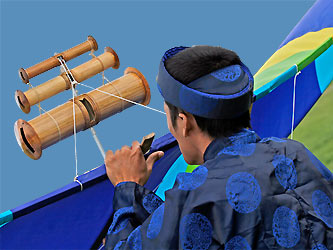 |
Change of continent. Papalote in Mexico, Barilete in Argentina and Guatemala, Volantin in Chile, Papagayo in Nicaragua, Honduras with Papelote, or Cometa in many other countries in South America (Colombia, Cuba, Ecuador, Panama, Peru , Uruguay ...), the kite is very popular in Latin America. Every country in Central America and South America has its own traditions. In Brazil, Pipas, kite fighting has a pentagonal shape, with a point down. It is made with tissue paper, chopsticks and cotton yarn.Unlike other kites fighting like Korean or Indian, the pipas has a long tail, called Rabiola, made of a single wire which is fixed strips of paper or plastic. The cuting line is made directly by the Brazilian with glycerol (a mixture of glue and ground glass). This thread made very abrasive and causes each year serious injuries. The Brazilian government is campaigning against the use of glycerol. The real Pipas territory: the suburbs of cities and especially in the overcrowded favelas, where street children have only one rule: "Cut all that flies." Today, kites are still scrambled for prisoners or drug traffickers in the favelas. |
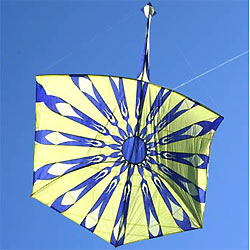 |
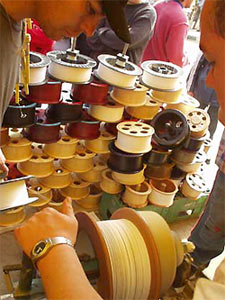 |
|
We are fortunate to have as friend Henry Prat, he knows the kite fighting in South America. He likes first and above all prepare his volantini, make good choice and strap them depending on the wind, try them before the fight and "feel" to make the best of each. He explained that the late 19th century that priests have started the practice of kite fighting in Chile, so they called "yarn priest". Its production has since become quasi-industrial and is live many families across the country. It is made by a process called "separado" (separated). The yarn is first dipped in hot jelly industrial, then passing through the quartz powder (the must). On 18 September the "Dia de la Patria" is the national holiday, a day of great enthusiasm for all Chileans.While the month before, it is traditional to buy the wire and "volantini" to fight with your family. Then we see the sky of the city into a huge "battlefield". The coils are called "carretes" (left photo: coil). The Indian cotton yarn, coated with powdered quartz, is directly dependent on the carrete client. The rods of volantini are "coligue" (pronounced coligoué), it looks like bamboo but do not have the mechanical qualities. |
|
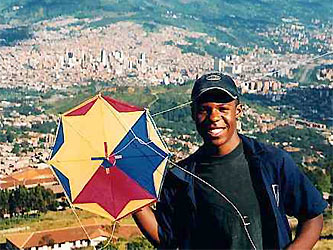 |
|
In Colombia, traditional kites do not date from the invasion of Spain as was long believed, but the Indians used them prior to their arrival. The kites are made with Colombian bamboo or "Yaripa" which is a plant of the family of bamboo, cane and corn. This word comes from the language of the Indians. The kite is flat with a tail. Its construction is made in family. Traditionally, the wire retainer, called "cabuya" is a braid of two or three strands of natural fibers, the "fique". To the tail of the kite, the Colombians use small pieces of old clothes cut, they weave with the "cabuya. Kite flying is a popular entertainment. Flying a kite in Colombia is a real expedition for the whole family participates. Often on Sundays, parents and children go to picnic and then go fly their cometas. "Our kites are very colorful and drawings adorn the very representative of our regional cultures." Ines said, the Association Yaripa |
|
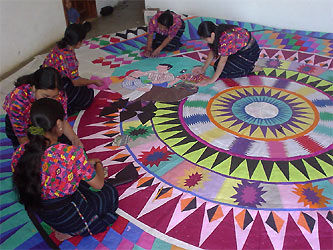 |
According to traditional legend, long ago, the cemetery Sumpango, Guatemala was invaded the day of the dead by evil spirits who were molesting the good souls of the dead. Today, "barrilete" (kite Guatemala) symbolize windows to communicate with the dead every year on All Saints Day. The kite Sumpango giants can reach a diameter of 15 meters. Exposed, they overlook the crowd, but others are more modest take flight, their size varies between 6 and 13 m. and weight between 100 and 150kg. The flight of these kites is impressive, and requires accuracy and thoroughness. The production starts 2 months before the festival from November 1. They are built with sensitivity and application. They are the result of a happy blend of technical craft, a sense of balance, color, know-how and from folklore tradition. The scenes tell their life: agriculture, economy, children, school.... For the inhabitants of Sumpango, origin Cakchiquel Maya, the feast of the dead has also become an opportunity to display their kites, their willingness to defend the values of the Mayan culture. |
You can read about these giants "they tore off our fruit They cut off our branches they burned our trunk, but they could not kill our roots!" "Every child saw a great relationship with his kite. It's more a game, it's part of our roots, our culture. It is a friend who often helps to live better, "explains Rafael Coyote Tum, director of learning Maya. It takes 45 consecutive days to a group of 35 people for 6 hours per day, to build a kite over 10 meters high. The frame of "barrilete" consists of strips of reed or bamboo locally (the cana) depending on the size of the kite. This structure is prepared on the night of October 31. It is assembled with hemp or wire tie, so as to achieve the traditional polygonal form. This activity is called "moon kite". The tail, also called "Patzunga" balance the kite, preventing it to go away for it is in the air. It consists of scraps of fabric that give the tailors of the city and a thick rope of agave.The length of the "Patzunga" depends on the size of the kite. |
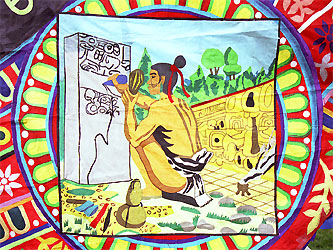 |
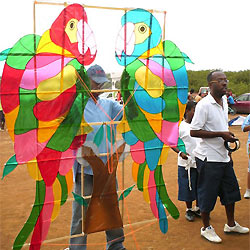 |
|
We were in email contact with Carol Jansen past few months because we wanted to participate in the festival of kites that their association organized to Curacao ... But it's Curacao is finally coming to us. In Dieppe, we gladly meet Carol and her team, and can almost see these beautiful kites on the leeward islands are really different. The traditional kites of Curacao are made with wood (or bamboo satay stick), crystal paper or plastic. These kites with bright colors are also designed in 3D. Carol was the first to use plastic in the manufacture of kites.She also created the Foundation Kite Curacao, "Fundashon di Fli Korsou" to promote the kite in Curacao, an island blessed with perfect weather and almost constant for the kite. |
|
